| Duration: | 01/2024 - 07/2026 |
| Contracting Authority/ Sponsors: |
Ministry for the Environment, Climate and Energy Sector Baden-Württemberg |
| Project Partners: |
|
| Project Focus: |
HyFaB3 – Production Research for Membrane-based Hydrogen Technologies
The aim of the "HyFaB3" project is to develop reference manufacturing processes for catalyst coated membranes (CCM) for the optimisation of electrolysis and fuel cell technologies. “HyFaB3” acts as a research and technology platform to optimize the use of materials in resource-critical components. A central goal is to scale the cell area, reduce the precious metal content and increase the throughput rates in order to support the market ramp-up of CCMs. In addition, Fraunhofer ISE is further developing the semi-automated production line built in the previous HyFaB projects for the production of full-format membrane electrode assemblies for PEM fuel cells in the section for cutting and laminating.
Challenge
In electrolyzers, water is split into oxygen and hydrogen using electrical energy. Hydrogen and oxygen, in turn, can be converted into electrical energy and water in a fuel cell. Both technologies are indispensable for the hydrogen economy, but expensive materials and a lack of industrialization processes are hindering widespread market penetration. The catalyst-coated membrane (CCM) is the “core element” of both technologies and consists of an ion exchange membrane coated on both sides with two electrodes (anode and cathode). In order to reduce manufacturing costs, the CCM manufacturing processes must be optimized.
The production of a CCM involves four steps:
- dispersing the catalyst ink (catalyst powder, ion exchange polymer, solvent)
- printing the catalyst ink to form a thin catalyst layer on a transfer foil or directly on the membrane
- drying the catalyst layer
- transferring the catalyst layers (anode and cathode) to the membrane by hot pressing
In order to integrate the CCM into an electrolyzer or a fuel cell, it must be cut, laminated and assembled together with gas diffusion layers or porous transport layers. Each step has a significant influence on the performance of the CCM and must be optimized individually.


Our services
The Hyfab3 project considers the entire MEA value chain, from the catalyst ink to the lamination of the MEA. In the front-end section, the production know-how and the technology platform for PEM fuel cells developed in the previous HyFaB projects are transferred to membrane-based electrolysis. In doing so, highly scalable printing technologies such as screen printing (suitable for sheet-to-sheet production) and slot die (suitable for roll-to-roll production) are being investigated with the aim of increasing the cell area for industry-relevant stack sizes and reducing the total precious metal loading to < 0.3 mg/cm² without impairing performance. Both printing methods are being investigated for CCMs for hydrogen production with both acidic (proton exchange membrane, PEM) and basic (anion exchange membrane, AEM) membranes. Finally, cutting and laminating processes for full-format MEAs for fuel cells are being expanded and optimized.
Results
We have already succeeded in producing electrodes with a thickness of approx. 0.5 µm and a precious metal content of less than 0.1 mg iridium/cm2 using scalable printing methods such as slot die coating (Figure 1). In addition, CCMs with an active area of 600 cm2 have already been produced (Figure 2).
Objective
The "HyFaB3" project focuses on upscaling production processes and supports market participants in their production development. It contributes to improving production standards and establishing the manufacturing of electrolysis and fuel cell components in Germany. The results are accessible to material suppliers, plant manufacturers, production companies and research institutions in order to advance production research.
The “HyFaB3” project is funded by the state of Baden-Württemberg with EUR 2,097,157.04. The grant guidelines are implemented by the project management organization in Karlsruhe.
